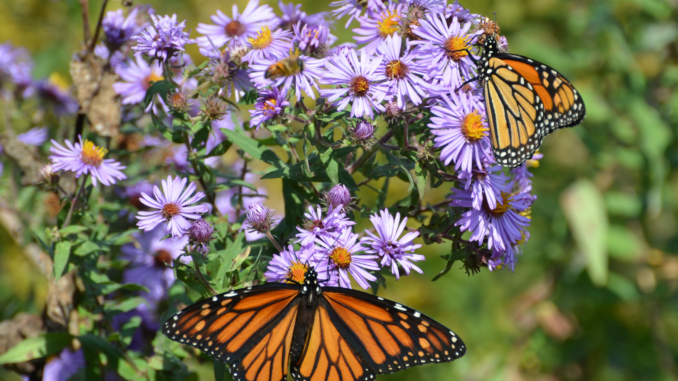

by Bryan Fischer, Horticulturist and Curator, Gardens on Spring Creek
We have all heard about the recent decline in monarch butterfly populations. We hear, too, that we should plant milkweed, or leave existing stands for monarch use. While this is true, it only paints a small portion of the picture that is the collective life of monarchs. This article will aim to add a few more brushstrokes to that canvas.
Monarchs, as many know, migrate more 2,000 miles from the mountains of Mexico to the northern United States. Adult monarchs rely on nectar plants (flowers), upon which the adults feed to fuel this massive journey. Once they arrive in the northern United States, they lay eggs on plants in the genus Asclepias (milkweeds). The caterpillars that hatch then feed on milkweed foliage, accumulate high levels of toxins produced by the plant. These toxins ensure monarchs are unpalatable to predators. The bright orange coloring of these butterflies serves as a warning sign to predators of this toxicity.
What many may not know, however, is that most monarch migrations occur in specific north-south bands that we refer to as flyways. The Front Range sits just on the edge of the Central United States flyway, meaning that most monarchs we see are on the edge of their path and are just passing through. Look to Asters (Symphyotrichum spp.), goldenrods (Solidago spp.), coneflowers (Echinacea spp.) and other prairie wildflowers to provide nectar for these travelers as they find their way back into the flyway. At five feet tall and magenta in color, Liatris ligulistylis (Rocky Mountain liatris) is a veritable monarch beacon. And, thanks to recent promotion by the Plant Select program, it should be easy for the gardener to find.
Local milkweed plants can still provide occasional breeding sites and valuable nectar to adults on the edge of the Central Flyway, though our gardens do not sit in prime monarch breeding range. A choice milkweed species for our area is Asclepias tuberosa, which is a clumping, rather than running, variety, making it ideal for garden culture. Expect narrow, dark green foliage on a slow-growing, xeric plant up to two feet. ‘Hello Yellow’ offers soft yellow flowers instead of the classic electric-orange seen on the straight species; both bloom in the second half of the summer. Other milkweeds can be appropriate for our region, but most will run. For wet or mesic (moderate water) gardens, consider swamp milkweed (A. incarnata), showy milkweed (A. speciosa) and others, but expect to manage their vigor. Tropical milkweed (A. curassavica) is best avoided, as it can harbor monarch parasites.
Though I provide this advice frequently, it is worth repeating: plant in stands and patches, with a diversity of species, and stagger bloom times to maximize wildlife benefit. Be sure to avoid plants grown with systemic insecticides, including neonicotenoids. You may have to ask a nursery staff member to get such information. With a fuller understanding of the picture that monarchs paint across the country each year, we can all color our yards a bit more brightly with their presence.
Support Northern Colorado Journalism
Show your support for North Forty News by helping us produce more content. It's a kind and simple gesture that will help us continue to bring more content to you.
BONUS - Donors get a link in their receipt to sign up for our once-per-week instant text messaging alert. Get your e-copy of North Forty News the moment it is released!
Click to Donate
